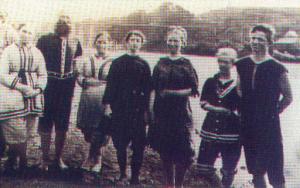Article from Spring 1999 Capitola Magazine
Capitola Museum presents a "not so revealing" look at Swimwear
by Carolyn Swift - former Director, Capitola Historical Museum
In olden days a glimpse of stocking
Was looked on a something shocking
Now, Heaven knows,
Anything goes.
-Cole Porter, Anything Goes, 1934
One summer day in July, 1889, an eager vacationer bounded from the bathhouse at Capitola and headed down the beach. When the young woman got to the water's edge, she went to lift up her skirt when -- horror of horrors -- she found she had no skirt and was clad only in bloomers.
Dazed, she stood in front of everyone, while half her bathing costume was back in the bathhouse yards away. The girl looked down, started to run back, then swung toward the surf as if to dart into the waves. Finally, she simply sank down in the sand, imploring the crowd for help.
Quickly, women on the beach rushed to her, fanning out their skirts and forming a circle of protection. Finally, a friend ran for the missing garment and the women passed it over their heads to the surf bather, "who put it on, no one knew how."
Capitola boasted that summer that it was visited by an estimated 1200 people "participating in the healthy sport of surf bathing," although only a few actually made it into the ocean. Most sat fully dressed along the shore, their white skin protected by parasols and hats. Except for the one embarrassing incident in July, all those who ventured near the water were all dressed with proper decorum.
Getting into the water was no easy task, especially for women, who had to cast off several pounds of convoluted inner and outer wear before they could even begin to don the Victorian bathing costume.
One of the earliest known Capitola beach photographs depicts men covered from their necks to their knees in flannel or wool, while the women were well hidden under long-sleeved, bloused tunics buttoned up the front, cinched at the waist, and worn over baggy bloomers. Inspired by Amelia Bloomer, some of these clumsy bathing costumes weighed up to twenty pounds when wet. Caps or bathing bonnets, stockings and laced-up surf shoes completed the traditional ensemble for women. Suits for men were either black or striped, so no one would mistake their attire for underwear.
Capitola vacationers could rent a suit if they needed. The bathhouses provided a dressing room, bathing suit, and towel for a dime in 1890.
Evolution of swim wear is as important to Capitola history as the invention of the five-cent hot dog. Families who spent their summers at the beach filled their picture albums with snapshot after snapshot of swimsuits that were ever shrinking.
As a symbol of freedom from the heavy constrictions of daily life, and because it is the hallmark of summertime leisure and good times by the sea, Capitola Museum has chosen the bathing suit as the theme for its next exhibit to open in June. Given the appropriate title "By-the-Sea," the exhibit will feature examples of swim wear worn throughout Capitola's past, from the itchy wool bloomers and lace up surf boots of the Victorian era to the printed cotton suits of the Thirties. The swimsuit culture of the 1940s and 1950s will also be explored.
Vintage bathing suits, beach wear, and accessories will be on display June 12 and through out the summer, from noon to 4 p.m. Friday, Saturday, and Sunday at the Capitola Museum, 410 Capitola Avenue, next to the Capitola trestle.
--Capitola Magazine Spring 1999, p. 25


